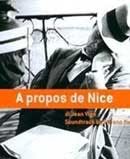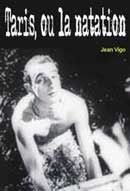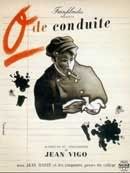Presento aquí mi candidata a filmografía más corta de DXC: La dedicada a ...
JEAN VIGO

Hijo de un famoso anarquista asesinado, Vigo se sobrepuso a la fatalidad en varias ocasiones durante su corta vida. Rodeado de poetas, escritores y luchadores sociales, el joven Vigo se inició en el cine con "A propósito de Niza" (1930) documental insólito por su descarnada visión crítica de la alta burguesía. Su segundo filme, "Taris" (1931) fue un cortometraje de encargo. Con "Cero en conducta" (1933) Vigo incursionó en el género de ficción, despertando la furia de la censura que prohibió su exhibición por trece años. Enfermo de tuberculosis crónica, Vigo filmó "L'Atalante" (1934) sin adivinar que sería su obra póstuma. Falleció a los 29 años, antes de verla estrenada. Sus películas permanecieron ignoradas hasta que los cineastas de la nueva ola las rescataron del olvido. A partir de entonces, su prestigio creció hasta convertirse en una de las figuras más atractivas del cine mundial ...
Para seguir leyendo, ir aquí:
LA FILMOGRAFÍA
À propos de Nice (1930)
Taris, roi de l'eau (1931)
Zéro de conduite (1933)
L'Atalante (1934)
 | À propos de Nice | 1930 | 25' | |
Vigo himself described the film as a social documentary, but it is clear to anyone watching the film that it is much more than that. The way in which Vigo contrasts the wealthy elite with the poor working class clearly shows where his sympathies lay. With some brilliant satirical touches, he ridicules his "social superiors", even contrasting them with wild animals (a self-important ostrich and viciously snapping crocodiles). Indeed some of the intrusive shots and awkward camera angles give the impression that Vigo is making a nature film, secretly spying on the exploits of some unfamiliar species of animal. All this goes to emphasise the extent to which he felt excluded from the kind of world he is filming in A propos de Nice. IMDB | DXC | ||||
| French | ||||
 | Taris, roi de l'eau | 1931 | 10' | |
| Dirigida por: Jean Vigo Reparto: Jean Taris (Himself) Jean Vigo’s second film is partly a homage to French swimming champion Jean Taris (who appears in the film as himself) but mainly as an experiment into the possibilities of underwater film photography. Although a short film, Taris is beautifully filmed and provided a source of inspiration to future film makers, most notably Jean Cocteau. IMDB | DXC | ||||
Subtítulos en castellano | French | |||
 | Zéro de conduite | Cero en conducta. | 1933 | 41' |
| Dirigida por: Jean Vigo Reparto: Jean Dasté (Monitor Huguet), Robert le Flon (Monitor 'Péte-Sec'), Du Verron (Chief monitor 'Bec-de-Gaz' (du Verron)), Delphin (Principal), Léon Larive (Sciences teacher (Larive)), Henri Storck (Priest)... Few films have that undeniable spark of genius that Jean Vigo’s Zéro de conduite has, and even fewer films reveal quite so much about their creator. Despite its short length (little over 40 minutes), some disjointed editing (resulting from Vigo not being given enough time by his studio to finish shooting the film) and the poor quality of the surviving print, this remains one of the defining and most imaginative films of the Twentieth century. IMDB | Culturalia | DXC | ||||
Subtítulos en castellano | French | |||
 | L'Atalante | L'Atalante | 1934 | 89' |
| Dirigida por: Jean Vigo Reparto: Michel Simon (Le père Jules), Dita Parlo (Juliette), Jean Dasté (Jean), Gilles Margaritis (Le camelot), Louis Lefebvre (Le gosse) At first sight, this would appear to be a pretty run-of-the-mill kind of love story. However, the end result is anything but ordinary, and the film is now almost universally regarded as one of the greatest and most influential French films ever made. This is all the more surprising given the troubled history of the film. After its initial showing in 1934, the film was subjected to a major re-edit, with many scenes moved around and 20 minutes of footage removed. The original score by Maurice Jaubert was replaced by a popular song and the film renamed "Le Chaland qui Passe". In spite of these changes, the film was poorly received and was a box office disaster. However, some years later, the film was restored to its original form and now is rightly regarded as a beautiful film and an important part of French cinema history. IMDB | Culturalia | DXC | ||||
Subtítulos en castellano | French | |||
¿Alguien da menos?
...Y UN LIBRO, EN ESPAÑOL, OIGA.

JEAN VIGO
Autor: PAULO EMILIO SALÈS GOMÈS
Editorial: CIRCE EDICIONES
Fecha de publicación: 26/10/1999.
Edición: 1ª
Número de páginas: 325.
ISBN: 8477651663.
Encuadernación: Rústica.
Tamaño: 21x13.
Ilustraciones en blanco y negro.
Traductor: Juan Abeleira.
Precio: 17€
Filmografías relacionadas
